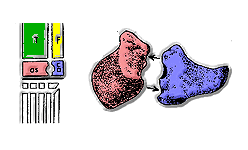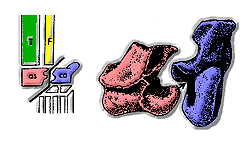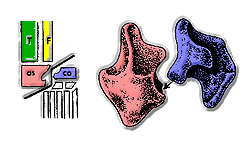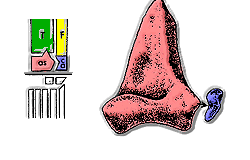
A | B | C | D | E | F | G | H | CH | I | J | K | L | M | N | O | P | Q | R | S | T | U | V | W | X | Y | Z | 0 | 1 | 2 | 3 | 4 | 5 | 6 | 7 | 8 | 9
| Archosaurs | |||
|---|---|---|---|
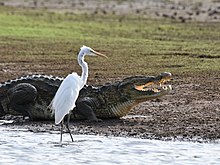
| |||
| Birds and crocodilians (in this case, a great egret and a mugger crocodile) are the only living archosaur groups. | |||
| Scientific classification | |||
| Domain: | Eukaryota | ||
| Kingdom: | Animalia | ||
| Phylum: | Chordata | ||
| Class: | Reptilia | ||
| Clade: | Archosauromorpha | ||
| Clade: | Archosauriformes | ||
| Clade: | Eucrocopoda | ||
| Clade: | Archosauria Cope, 1869 | ||
| Subgroups | |||
| |||
| Synonyms | |||
| |||
Archosauria (lit. 'ruling reptiles') or archosaurs (/ˈɑːrkəˌsɔːr/[3]) is a clade of diapsid sauropsid tetrapods, with birds and crocodilians being the only extant representatives. Although broadly classified as reptiles, which traditionally exclude birds, the cladistic sense of the term includes all living and extinct relatives of birds and crocodilians such as non-avian dinosaurs, pterosaurs, phytosaurs, aetosaurs and rauisuchians as well as many Mesozoic marine reptiles. Modern paleontologists define Archosauria as a crown group that includes the most recent common ancestor of living birds and crocodilians, and all of its descendants.
The base of Archosauria splits into two clades: Pseudosuchia, which includes crocodilians and their extinct relatives; and Avemetatarsalia, which includes birds and their extinct relatives (such as non-avian dinosaurs and pterosaurs).[4] Older definitions of the group Archosauria rely on shared morphological characteristics, such as an antorbital fenestra in the skull, serrated teeth, and an upright stance. Some extinct reptiles, such as proterosuchids and euparkeriids, also possessed these features yet originated prior to the split between the crocodilian and bird lineages. The older morphological definition of Archosauria nowadays roughly corresponds to Archosauriformes, a group named to encompass crown-group archosaurs and their close relatives.[4]
The oldest true archosaur fossils are known from the Early Triassic period, though the first archosauriforms and archosauromorphs (reptilians closer to archosaurs than to lizards or other lepidosaurs) appeared in the Permian. Archosaurs quickly diversified in the aftermath of the Permian-Triassic mass extinction (~252 Ma), which wiped out most of the then-dominant therapsid competitors such as the gorgonopsians and anomodonts, and the subsequent arid Triassic climate allowed the more drought-resiliant archosaurs (largely due to their uric acid-based urinary system) to eventually become the largest and most ecologically dominant terrestrial vertebrates from the Middle Triassic period up until the Cretaceous–Paleogene extinction event (~66 Ma).[5] Birds and several crocodyliform lineages were the only archosaurs to survive the K-Pg extinction, rediversifying in the subsequent Cenozoic era. Birds in particular have become among the most species-rich groups of terrestrial vertebrates in the present day.
Distinguishing characteristics
Archosaurs can traditionally be distinguished from other tetrapods on the basis of several synapomorphies, or shared characteristics, which were present in their last common ancestor. Many of these characteristics appeared prior to the origin of the clade Archosauria, as they were present in archosauriforms such as Proterosuchus and Euparkeria, which were outside the crown group.[4]
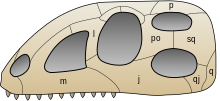
The most obvious features include teeth set in deep sockets, antorbital and mandibular fenestrae (openings in front of the eyes and in the jaw, respectively),[6] and a pronounced fourth trochanter (a prominent ridge on the femur).[7] Being set in sockets, the teeth were less likely to be torn loose during feeding. This feature is responsible for the name "thecodont" (meaning "socket teeth"),[8] which early paleontologists applied to many Triassic archosaurs.[7] Additionally, non-muscular cheek and lip tissue appear in various forms throughout the clade, with all living archosaurs lacking non-muscular lips, unlike most non-avian saurischian dinosaurs.[9] Some archosaurs, such as birds, are secondarily toothless. Antorbital fenestrae reduced the weight of the skull, which was relatively large in early archosaurs, rather like that of modern crocodilians. Mandibular fenestrae may also have reduced the weight of the jaw in some forms. The fourth trochanter provides a large site for the attachment of muscles on the femur. Stronger muscles allowed for erect gaits in early archosaurs, and may also be connected with the ability of the archosaurs or their immediate ancestors to survive the catastrophic Permian-Triassic extinction event.[citation needed]
Unlike their close living relatives, the lepidosaurs, archosaurs lost the vomeronasal organ.[10]
Origins
Archosaurs are a subgroup of archosauriforms, which themselves are a subgroup of archosauromorphs. Both the oldest archosauromorph (Protorosaurus speneri) and the oldest archosauriform (Archosaurus rossicus) lived in the late Permian. The oldest true archosaurs appeared during the Olenekian stage (247–251 Ma) of the Early Triassic. A few fragmentary fossils of large carnivorous crocodilian-line archosaurs (informally termed "rauisuchians") are known from this stage. These include Scythosuchus and Tsylmosuchus (both of which have been found in Russia),[11] as well as the Xilousuchus, a ctenosauriscid from China.[4] The oldest known fossils of bird-line archosaurs are from the Anisian stage (247–242 Ma) of Tanzania, and include Asilisaurus (an early silesaurid), Teleocrater (an aphanosaur), and Nyasasaurus (a possible early dinosaur).[citation needed]
Archosaurian domination in the Triassic
Synapsids are a clade that includes mammals and their extinct ancestors. The latter group are often referred to as mammal-like reptiles, but should be termed protomammals, stem mammals, or basal synapsids, because they are not true reptiles by modern cladistic classification. They were the dominant land vertebrates throughout the Permian, but most perished in the Permian–Triassic extinction event. Very few large synapsids survived the event, but one form, Lystrosaurus (a herbivorous dicynodont), attained a widespread distribution soon after the extinction.[12] Following this, archosaurs and other archosauriforms quickly became the dominant land vertebrates in the early Triassic. Fossils from before the mass extinction have only been found around the Equator, but after the event fossils can be found all over the world.[13] Suggested explanations for this include:
- Archosaurs made more rapid progress towards erect limbs than synapsids, and this gave them greater stamina by avoiding Carrier's constraint. An objection to this explanation is that archosaurs became dominant while they still had sprawling or semi-erect limbs, similar to those of Lystrosaurus and other synapsids.[citation needed]
- Archosaurs have more efficient[clarification needed] respiratory systems featuring unidirectional air flow, as opposed to the tidal respiration of synapids.[14] The ability to breathe more efficiently in hypoxic conditions may have been advantageous to early archosaurs during the suspected drop in oxygen levels at the end of the Permian.[14]
- The Early Triassic was predominantly arid, because most of the Earth's land was concentrated in the supercontinent Pangaea. Archosaurs were probably better at conserving water than early synapsids because:
- Modern diapsids (lizards, snakes, crocodilians, birds) excrete uric acid, which can be excreted as a paste, resulting in low water loss as opposed to a more dilute urine. It is reasonable to suppose that archosaurs (the ancestors of crocodilians, dinosaurs and pterosaurs) also excreted uric acid, and therefore were good at conserving water. The aglandular (glandless) skins of diapsids would also have helped to conserve water.[citation needed]
- Modern mammals excrete urea, which requires a relatively high urinary rate to keep it from leaving the urine by diffusion in the kidney tubules. Their skins also contain many glands, which also lose water. Assuming that early synapsids had similar features, e.g., as argued by the authors of Palaeos, they were at a disadvantage in a mainly arid world. The same well-respected site points out that "for much of Australia's Plio-Pleistocene history, where conditions were probably similar, the largest terrestrial predators were not mammals but gigantic varanid lizards (Megalania) and land crocs."[8]
However, this theory has been questioned, since it implies synapsids were necessarily less advantaged in water retention, that synapsid decline coincides with climate changes or archosaur diversity (neither of which tested) and the fact that desert dwelling mammals are as well adapted in this department as archosaurs,[15] and some cynodonts like Trucidocynodon were large sized predators.[16] A study favors competition amidst mammaliaforms as the main explanation for Mesozoic mammals being small.[17]
Main forms

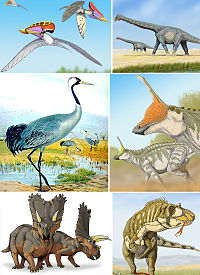
Since the 1970s, scientists have classified archosaurs mainly on the basis of their ankles.[18] The earliest archosaurs had "primitive mesotarsal" ankles: the astragalus and calcaneum were fixed to the tibia and fibula by sutures and the joint bent about the contact between these bones and the foot.
The Pseudosuchia appeared early in the Triassic. In their ankles, the astragalus was joined to the tibia by a suture and the joint rotated round a peg on the astragalus which fitted into a socket in the calcaneum. Early "crurotarsans" still walked with sprawling limbs, but some later crurotarsans developed fully erect limbs. Modern crocodilians are crurotarsans that can employ a diverse range of gaits depending on speed.[19]
Euparkeria and the Ornithosuchidae had "reversed crurotarsal" ankles, with a peg on the calcaneum and socket on the astragalus.
The earliest fossils of Avemetatarsalia ("bird ankles") appear in the Anisian age of the Middle Triassic. Most Ornithodirans had "advanced mesotarsal" ankles. This form of ankle incorporated a very large astragalus and very small calcaneum, and could only move in one plane, like a simple hinge. This arrangement, which was only suitable for animals with erect limbs, provided more stability when the animals were running. The earliest avemetatarsalians, such as Teleocrater and Asilisaurus, retained "primitive mesotarsal" ankles. The ornithodirans differed from other archosaurs in other ways: they were lightly built and usually small, their necks were long and had an S-shaped curve, their skulls were much more lightly built, and many ornithodirans were completely bipedal. The archosaurian fourth trochanter on the femur may have made it easier for ornithodirans to become bipeds, because it provided more leverage for the thigh muscles. In the late Triassic, the ornithodirans diversified to produce dinosaurs and pterosaurs.
Classification
Modern classification
Archosauria is normally defined as a crown group, which means that it only includes descendants of the last common ancestors of its living representatives. In the case of archosaurs, these are birds and crocodilians. Archosauria is within the larger clade Archosauriformes, which includes some close relatives of archosaurs, such as proterochampsids and euparkeriids. These relatives are often referred to as archosaurs despite being placed outside of the crown group Archosauria in a more basal position within Archosauriformes.[20] Historically, many archosauriforms were described as archosaurs, including proterosuchids and erythrosuchids, based on the presence of an antorbital fenestra. While many researchers prefer to treat Archosauria as an unranked clade, some continue to assign it a traditional biological rank. Traditionally, Archosauria has been treated as a Superorder, though a few 21st century researchers have assigned it to different ranks including Division[21] and Class.[22]
History of classification
Archosauria as a term was first coined by American paleontologist Edward Drinker Cope in 1869, and included a wide range of taxa including dinosaurs, crocodilians, thecodonts, sauropterygians (which may be related to turtles), rhynchocephalians (a group that according to Cope included rhynchosaurs, which nowadays are considered to be more basal archosauromorphs, and tuataras, which are lepidosaurs), and anomodonts, which are now considered synapsids.[23] It was not until 1986 that Archosauria was defined as a crown-clade, restricting its use to more derived taxa.[24]
Cope's term was a Greek-Latin hybrid intended to refer to the cranial arches, but has later also been understood as "leading reptiles" or "ruling reptiles" by association with Greek ἀρχός "leader, ruler".[25]
The term "thecodont", now considered an obsolete term, was first used by the English paleontologist Richard Owen in 1859 to describe Triassic archosaurs, and it became widely used in the 20th century. Thecodonts were considered the "basal stock" from which the more advanced archosaurs descended. They did not possess features seen in later avian and crocodilian lines, and therefore were considered more primitive and ancestral to the two groups. With the cladistic revolution of the 1980s and 90s, in which cladistics became the most widely used method of classifying organisms, thecodonts were no longer considered a valid grouping. Because they are considered a "basal stock", thecodonts are paraphyletic, meaning that they form a group that does not include all descendants of its last common ancestor: in this case, the more derived crocodilians and birds are excluded from "Thecodontia" as it was formerly understood. The description of the basal ornithodires Lagerpeton and Lagosuchus in the 1970s provided evidence that linked thecodonts with dinosaurs, and contributed to the disuse of the term "Thecodontia", which many cladists consider an artificial grouping.[26]
With the identification of "crocodilian normal" and "crocodilian reversed" ankles by Sankar Chatterjee in 1978, a basal split in Archosauria was identified. Chatterjee considered these two groups to be Pseudosuchia with the "normal" ankle and Ornithosuchidae with the "reversed" ankle. Ornithosuchids were thought to be ancestral to dinosaurs at this time. In 1979, A.R.I. Cruickshank identified the basal split and thought that the crurotarsan ankle developed independently in these two groups, but in opposite ways. Cruickshank also thought that the development of these ankle types progressed in each group to allow advanced members to have semi-erect (in the case of crocodilians) or erect (in the case of dinosaurs) gaits.[26]
Phylogeny
In many phylogenetic analyses, archosaurs have been shown to be a monophyletic grouping, thus forming a true clade. One of the first studies of archosaur phylogeny was authored by French paleontologist Jacques Gauthier in 1986. Gauthier split Archosauria into Pseudosuchia, the crocodilian line, and Ornithosuchia, the dinosaur and pterosaur line. Pseudosuchia was defined as all archosaurs more closely related to crocodiles, while Ornithosuchia was defined as all archosaurs more closely related to birds. Proterochampsids, erythrosuchids, and proterosuchids fell successively outside Archosauria in the resulting tree. Below is the cladogram from Gauthier (1986):[27]
In 1988, paleontologists Michael Benton and J. M. Clark produced a new tree in a phylogenetic study of basal archosaurs. As in Gauthier's tree, Benton and Clark's revealed a basal split within Archosauria. They referred to the two groups as Crocodylotarsi and Ornithosuchia. Crocodylotarsi was defined as an apomorphy-based taxon based on the presence of a "crocodile-normal" ankle joint (considered to be the defining apomorphy of the clade). Gauthier's Pseudosuchia, by contrast, was a stem-based taxon. Unlike Gauthier's tree, Benton and Clark's places Euparkeria outside Ornithosuchia and outside the crown group Archosauria altogether.[28]
The clades Crurotarsi and Ornithodira were first used together in 1990 by paleontologist Paul Sereno and A. B. Arcucci in their phylogenetic study of archosaurs. They were the first to erect the clade Crurotarsi, while Ornithodira was named by Gauthier in 1986. Crurotarsi and Ornithodira replaced Pseudosuchia and Ornithosuchia, respectively, as the monophyly of both of these clades were questioned.[26][29] Sereno and Arcucci incorporated archosaur features other than ankle types in their analyses, which resulted in a different tree than previous analyses. Below is a cladogram based on Sereno (1991), which is similar to the one produced by Sereno and Arcucci:[26]

